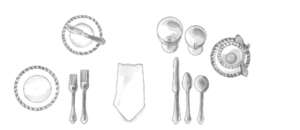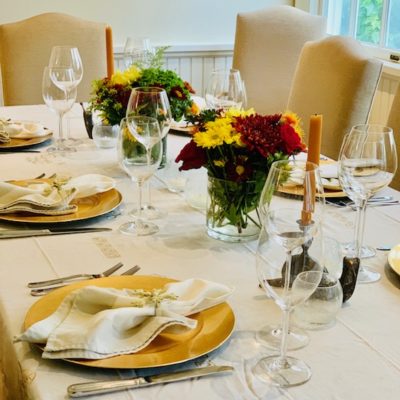The art of the table, and knowing which rules to break

creating a beautiful table and setting the tone
…it is always better to know the rules and then decide on which ones to break.
In the mid 17th century at the court of Louis XIV in France the ‘art of the table’ began to take shape with a set of formal rules. The idea of ‘fine eating’ became a demonstration of extravagant displays of wealth and abundance while showcasing the prowess of the chef.
Meals often included twenty to thirty courses served over many hours of revelry. Each course- hors d’oeuvre, soup, main dish, in-between dishes and fruit were composed of two to eight grandiose dishes.
Louis XIV was known for his meticulous attention to detail combined with a strict work ethic. During his reign, food and table presentation became another expression of art, created through the symphony of elaborate food displays, beautiful table linens, fine china, ornate silver and the finest attention to the balance and harmony of all elements.
In the late 18th century serving food from a wheeled trolley, or Russian style, became fashionable when first introduced to society by a Russian prince living in Paris. Table service evolved further in the 19th century when English-style service began with dining staff carrying dishes to the table and guests serving themselves from each plate presented. English style was later adapted into fine dining restaurants, and is only today found in more formal, high end restaurants.
Our more modern day traditions of table setting and service continue to follow much of the French tradition. The table linens, glasses, centerpieces express the tone of an engagement- whether a casual BBQ with colorful paper napkins and plates, or a dinner party with Richard Ginori china and Baccarat glassware.
Let your table reflect you and your guests
I once went to lunch at a friend’s house and she had the most beautiful glasses and dishes on the table. I asked her why the gorgeous table just for the four of us? She exclaimed, “Why just use your grandmother’s glasses or wedding place sets for special occasions?”
Why not use the things you love no matter what the occasion? Or mix things up with some very special pieces and others that are more every day. Use what you have and enjoy it.
I think of what she said every time I set a table. I love setting my table because it is a time to be creative. I start by thinking of what is being served- is it Asian or Italian or a grilled fish or meat, do I want the tone to be easy and light or should this be a more formal setting? I even think about how well the guests know each other because whimsical place cards or candies, can lighten the mood and bring people together. The point is to make people feel welcome the minute they sit down.
Basic rules
There are basic ‘rules’ to setting a table properly but of course rules are sometimes meant to be broken and by all means make up your own if you see fit. But I think it is always better to know and understand the rules and then decide which ones to break.
Table
- If using a table cloth, use table pads or using double tablecloth not only protect the table but minimize noise when placing down any table items.
- Lay placemats in front of each chair or tablecloth evenly around the table.
- You want enough room for each guest to eat comfortably, ideally 8 to 12 inches (20 to 40 centimeters) between each place.
- Put a dinner plate or charger onto the placemat or tablecloth- this is the centerpiece of the setting and should be set down before anything else.
- Standing behind each dining chair, center the dinner plate or charger on the table measuring one thumb from edge of table or edge of placemat.

Utensils (cutlery or silverware)
- Utensils are placed in the order used.
- Place dinner fork on the left side of plate, and knife on right.
- The cutting edge of knife should face in towards the dinner plate.
- If having an appetizer, the utensils go next to the dinner fork or knife and so on.
- I usually do not place dessert forks out on table due to space but you can place above the dinner plate, and by doing so, this is a more informal setting.
- Salad plates are rested to the left of the forks
- Bread plates are above the tines of the fork, or if not having a salad place on left of the forks.

In more formal settings, the dessert cutlery is either next to the dinner plate, or brought out with the dessert. And as a general rule, there should be no more than three utensils on each side of dinner plate (three courses).…..the exception being an oyster fork if you really get fancy. If you have a fourth course the necessary utensils are placed down prior to the fourth course being served.
On a French table, you often see the utensils placed with the tines of the fork facing downwards. The tradition began when upper class French households decided to show the silversmith’s hallmark on the underside of the fork. Nowadays it can be placed either up or down. In England and American that tradition of reversed tines was never practiced.
In more casual American settings, particularly outdoor, the fork and knife may be together on the plate or to the left of the plate on the napkin. It is pretty and adds a point of difference.
Glassware
The placement of glassware is standard. The water glass is positioned just above the knife and often set off the placemat or about one inch from the tip of the knife.
The white wine glass is to the right of the water glass, and the red wine to the left, followed by any other glass to left next to red wine glass. You either form the glasses in a linear fashion or in a grouping. I usually use just one wine glass to make it easier, unless it is a more formal dinner with different wines per course.

Dessert utensils (cutlery or silverware)
The formal way is to place the dessert cutlery next to the dinner plate on left and right side. Meaning it would be placed before dinner knife and fork. If you are lucky enough to go to a state dinner at Buckingham Palace, this is what you will find. (You will also find that members of the Royal family often are served something different than the rest of the guests).
The informal setting is to place the dessert spoon above the dinner plate with the handle to the right, and dessert fork above spoon with handle facing to the left. You can also do this if serving a cheese course, replacing spoon with small knife.
Of course, in most restaurants the cutlery is placed down before each course but you are not serving in a restaurant, and having is laid out is one less thing to worry about.
Place cards
If using a place card, the most formal is centering it to the plate. Otherwise you can put it anywhere, on the napkin, above the fork, or sometimes, I use a dry erase marker and put the name of the guest on the water or wine glass. Easy and much less formal.
Menus
When using menus, place on the plate or to the right of the plate. In formal setting the menu should not be propped up and resting on the glassware.



